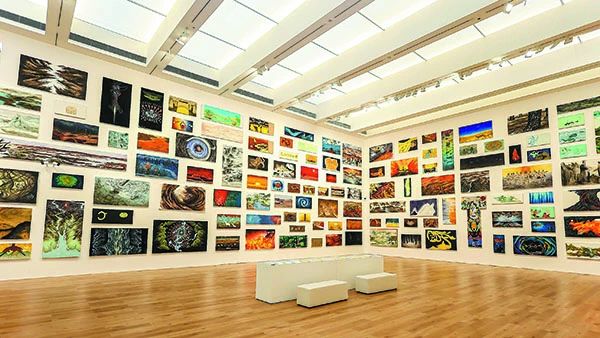【Life】Documentary paints picture of country's emergence
2023年12月07日 10:13 点击:[]
How did China become the country it is today? This is the question that documentary director Li Dongshen aims to explore in his three-season documentary series,
China
.
▲
An ongoing art exhibition echoing the recently aired third season of the documentary, China, displays 443 paintings centered on mythologies and stories of ancient China. [Photo provided to China Daily]
The first season, which aired in late 2020, traces the dynasties from the Spring and Autumn Period (770-476 BC), which were marked by the emergence of different schools of thought, to the heyday of the Tang Dynasty (618-907). The second season, released in 2022, extended the narrative all the way to the Xinhai Revolution launched by Sun Yat-sen in 1911.
Both seasons received widespread acclaim for their artistic portrayal of history, evocative scores, and literary, emotionally rich voice-overs, earning ratings of 8.3 and 8.9 out of 10 on the review site Douban, respectively.
"All the stories we selected for the documentary contribute to making clear the logic of how China has developed into the large, inclusive, united multiethnic country of today," Li explains.
In the third season, which recently aired on Hunan Satellite TV and online video-sharing platform Mango TV, Li deviated from a chronological narrative, picking up from where he left off in season two, but choosing to delve further into the past.
▲
Director Li Dongshen [Photo provided to China Daily]
Starting with the mythological story of how Pangu created the world and all living things, the latest season explores the tales of mythological deities like Fuxi, Nuwa and Shennong, and seeks to unearth the wisdom inherent in mythology, highlighting the ancient Chinese exploration of geography, astronomy, calendrical systems, as well as the enigmas of life and death.
The question was how to present mythological tales in a documentary. Li's innovative approach involved assembling 183 young artists with an average age of 27, who, over the course of 200-odd days, made 1,000 paintings inspired by the stories that the documentary plans to tell. These artworks, which predominantly reflect traditional Chinese artistic styles, vividly portray the ethereal characters and events of ancient legends.
Computer graphics technologies are then used to animate the paintings, lending them additional visual expressiveness.
The production unit invited a host of historians and archaeologists, including Wang Zijin, Xu Hong, Sha Wutian and Ruan Mingtao, to serve as academic consultants, and extensively researched archaeological materials and historical documents to present the origins of the Chinese spirit of humanism in precise and accurate language.
For the portrayal of deities, Li has opted for an approach to imagery that obscures their frontal forms, providing viewers with the sense of gazing at them from a distance, instead.
"This is a sensation that cannot be captured through conventional filming techniques. I gave the artists two suggestions. First, I preferred to avoid specific portraits, and second, I wanted to incorporate the symbolism of eyes. Gods are human creations, yet they also cast their gaze upon us," Li says.
"The entire season, from its first episode to its last, is like an exhibition of paintings," Li adds.
▲
The exhibition being held in Changsha, Hunan province, runs from Nov 14 to Feb 18, and has attracted many young visitors. [Photo by Xing Wen/China Daily]
The Hunan Broadcasting System, which produced the series, has already turned some of those paintings into a real-life art exhibition, where 443 of the aforementioned 1,000 paintings are on display at Mango Art Museum in Changsha, Hunan province, from Nov 14 to Feb 18. Primary and middle school students have free entry to the exhibition on Saturdays.
Peng Feng, director of the School of Arts at Peking University, was invited to curate. He says that in an age where artificial intelligence presents a challenge to human painting, the documentary adopted a counterintuitive approach by employing 183 artists to paint all the necessary images.
"This arduous, yet unrewarded endeavor, is surely intriguing," he says.
Peng further believes that the project means a lot to painting.
"Sometimes, artists can be more creative within constraints than in unrestricted circumstances, offering them a crucial opportunity for self-discovery," he adds.
Shan Haoxiang, Mo Lijia and Ren Gang were some of those young artists involved.
"I believe that the making of the documentary series has opened up new visions for us in artistic creation. It explores the possible fusion of painting, documentary filmmaking and new media technology," Shan says.
Mo feels the project has opened up new horizons. "Normally, artists work independently, and what we create largely expresses our individual selves. I'm not usually inclined to collaborate, but this project, with over 180 artists working together, has expanded possibilities," Mo says.
For Ren, the project ignited a passion for creation.
"When we first received the script, we had to imagine the splendor of ancient Chinese mythology, which generated feelings of excitement and fervor," he recalls.
上一条:【“城”就未来】6165cc金沙总站与波方教师赴天津泰达绿化科技集团股份有限公司开展访企拓岗
下一条:第八届全国学生“学宪法 讲宪法”活动来了!
【关闭】

